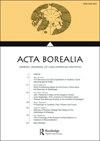The governance of urban indigenous spaces: Norwegian Sámi examples
IF 0.6
4区 社会学
0 HUMANITIES, MULTIDISCIPLINARY
引用次数: 10
Abstract
ABSTRACT How do different ways of governing urban indigenous social spaces facilitate or frustrate local indigenous self-government? A major challenge in Norway is the absence of actors that represent the entire local indigenous population. The main Norwegian Sámi NGO is a driving force in establishing and governing indigenous spaces, but is now one of several and often competing organizations due to specialization (new organizations form to promote specific subgroups' interests) and partisanization (organizations compete in elections to the Sámediggi representative organ). Social media facilitate communication across organizational divides, but do not produce any unified local indigenous “voice”. Private businesses and public cultural institutions take part in establishing and governing indigenous spaces – the former often in complete autonomy from Sámi NGOs, the latter more likely to seek cooperation or coordination. Local and regional state-based actors generally do not take initiatives to establish indigenous spaces, but involve themselves as co-organizers with Sámi leads and as sources of (often unstable) economic support. The state-based Sámediggi is increasingly proactive: financing, facilitating contact between actors, and occasionally participating directly in urban indigenous governance. The Sámediggi provides a unifying representative voice at the macro level that is missing at the local level.城市土著空间的治理:挪威萨米人的例子
管理城市土著社会空间的不同方式是如何促进或阻碍地方土著自治的?挪威面临的一个主要挑战是缺乏代表整个当地土著人口的行动者。主要的挪威萨米非政府组织是建立和管理土著空间的推动力,但由于专业化(新组织的成立是为了促进特定群体的利益)和党派化(组织在萨米代表机构的选举中竞争),它现在是几个经常相互竞争的组织之一。社交媒体有助于跨越组织分歧进行沟通,但不会产生任何统一的当地土著“声音”。私营企业和公共文化机构参与建立和管理土著空间——前者通常完全独立于萨米非政府组织,后者更有可能寻求合作或协调。地方和地区性的国家行为者通常不会主动建立土著空间,而是作为与萨米人领导人的共同组织者和(往往不稳定的)经济支持的来源。总部位于国家的Sámediggi越来越积极主动:提供资金,促进行为者之间的联系,偶尔直接参与城市土著治理。Sámediggi在宏观层面提供了一种统一的代表性声音,而这在地方层面是缺失的。
本文章由计算机程序翻译,如有差异,请以英文原文为准。
求助全文
约1分钟内获得全文
求助全文

 求助内容:
求助内容: 应助结果提醒方式:
应助结果提醒方式:


